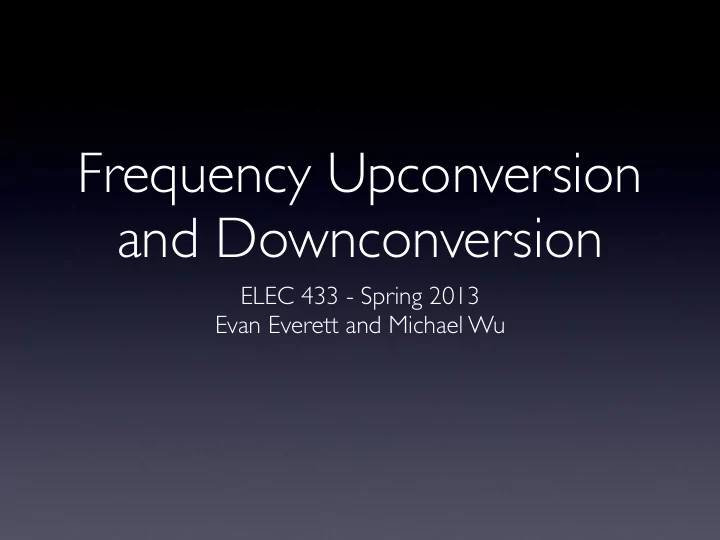

Frequency Upconversion and Downconversion ELEC 433 - Spring 2013 Evan Everett and Michael Wu
Transmit Chain Data ∼ ∼ D/A ∼ ∼ ∼ ∼ Baseband RF Upconversion Upconversion
RF Up/Downconversion • Purpose: • Baseband is great for processing • RF better for propagation RF Baseband Tx Baseband Rx Channel Processing Processing X C ( f ) X ( f ) X ( f ) f C − f C
RF Upconversion • Goal: Convert complex I/Q samples at baseband to real signal centered at carrier • Strategy: shift in frequency is multiplication by x ( t ) e j 2 πf c t ↔ X ( f − f C ) sinusoid in time: • Remember the reality condition: If is real x ( t ) then X ( − f ) = X ∗ ( f ) X C ( f ) X ( f ) X ( f − f C ) X ∗ ( f + f C ) f C − f C
RF Upconversion Briefly discussed in Modulation lab: Text
RF Upconversion xI(t) cos(2 π ƒct) xc(t) -sin(2 π ƒct) xQ(t)
RF Upconversion x ( t ) = x I ( t ) + jx Q ( t ) x C ( t ) = x I ( t ) cos(2 πf C t ) − x Q ( t ) sin(2 πf c t ) xI(t) = | x ( t ) | cos (2 πf C t − ∠ x ( t )) cos(2 π ƒct) = Re[ x ( t ) e j 2 πf C t ] xc(t) -sin(2 π ƒct) X C ( f ) = X ∗ ( f + f C ) + X ( f − f C ) xQ(t) X ( f ) X C ( f ) X ∗ ( f + f C ) X ( f − f C ) f C − f C
RF Downconversion • Goal: Convert real-valued signal at carrier to I/Q samples at baseband • Strategy: shift (multiply by sinusoid) and filter
RF Downconversion 1) Shift by ƒ c by multiplying by a complex sinusoid X C ( f ) x c ( t ) e jπf c t f C 2 f C − f C 2) Lowpass Filter to remove high frequency content X ( f ) 2 f C
RF Up/Downconversion X C ( f ) X ( f ) X ( f ) − f C f C 2 f C cos(2 ! ƒct) xI(t) xI(t) LPF xc(t) cos(2 ! ƒct) -sin(2 ! ƒct) xQ(t) sin(2 ! ƒct) xQ(t) LPF Channel-ready signal Source I/Q signals Recovered I/Q signals
Transmit Chain • WARP radios implement RF upconversion and downconversion for us Data ∼ ∼ D/A ∼ ∼ ∼ ∼ RF Baseband Upconversion Upconversion
Transmit Chain • WARP radios implement RF upconversion and downconversion for us Data WARP ∼ D/A ∼ Radio ∼ Baseband Upconversion • This week you will be implementing digital baseband up/downcoversion
Baseband Up/Downconversion • Reason: most radios reject DC input due to an RF issue called DC offset (a.k.a. carrier leakage) I AC coupled Radio I/Q inputs Q • Goal: shift I/Q samples away from DC • Difference from RF upconversion: output is still complex (I/Q)
Baseband+RF Upconversion • Radio’s usable input spectrum has a notch at DC • Shift I/Q samples to an intermediate frequency f IF ! f IF f RF DC IF RF via FPGA via Radio
Baseband Up/Downconversion f IF upconverted xI(t) xI(t) xI(t) cos(2 ! ƒct) cos(2 ! ƒct) sin(2 ! ƒct) -sin(2 ! ƒct) xQ(t) xQ(t) upconverted xQ(t) Complex Multiplication Complex Multiplication
A Few Complications upconverted xI(t) xI(t) xI(t) cos(2 ! ƒct) cos(2 ! ƒct) sin(2 ! ƒct) -sin(2 ! ƒct) xQ(t) xQ(t) upconverted xQ(t) • Desired symbol rate = 5 Mhz, DAC sample clock = 40Mhz • Before upconversion, upsample I/Q signals by 8 then filter (we know how to build efficient interpolaters). • Do opposite on the receiver side. • Delay between Tx and Rx: what if the receiver starts listening after a transmitter begins sending? • Tx/Rx carrier frequency mismatch: residual frequency left at receiver
Recommend
More recommend